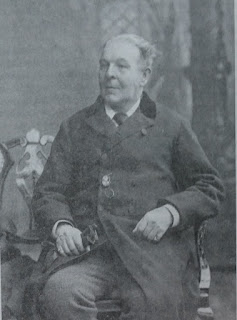A man who shot his wife and son dead in 1841 as he believed they faced financial ruin was cleared of murder on the grounds of insanity.
William Jenner was a cotton broker living in Portland Place with his wife and two teenage sons. He had always been an affectionate husband and father and although finances hadn't been as good recently as he would have liked, he was sufficiently well off to employ two servant maids.
In April 1841 the Jenner family were due to move home but early in the morning on the 27th of that month, as the maids slept at the new premises, an awful tragedy unfolded in Portland Place. At around 6am George Jenner was woken by the sound of a gunshot. He woke to see his father standing by his brother William's bed holding a pistol in his hand. George leaped out of bed and tried to take the pistol from his father but could not do so. He then ran downstairs to try and get out into the street but could not unfasten the door and then heard another gunshot.
When George went into the parlour his father was there and this time he did manage to seize two pistols from him. He then went to his parents' bedroom but his mother was not there. Soon afterwards, George heard the sound of crying from the kitchen and on going there he found his mother lying on the floor with blood coming out of her head.
George managed to get out of the back door and told his father he would throw the pistols away and look for a surgeon and policeman. Within ten minutes both Dr Ackerley and a policeman had arrived, to be told by Jenner that a Mr Roberts had ruined him. The pistols were recovered from the midden and a police inspector was sent for. A search of the house took place and receipts for the pistols were recovered, as well as laudanum and powder. Jenner said he loved his wife and had two fine boys, but they would all be better in the grave.
While in the custody of officers Jenner asked George to kiss him but he was too afraid to. Jenner said that because of Mr Roberts the family would be in poverty and that he had intended to shoot George too.
Mary Jenner was still alive and sensible. She was taken to hospital where she gave a deposition which stated that she just felt a sensation and thought she was taking a fit. The ball was removed but her condition worsened and she died on 6th May.
On 24th August Jenner appeared at the assizes, where his demeanour was much calmer than it had been in the immediate aftermath of the killings. Opening the case for the prosecution, Mr Starkie told the jury the main question they had to consider was whether Jenner was of sound mind at the time. George bravely recounted the events and stated that his father had at other times been in states of excitement and red faced, and had been known to take prussic acid.
Dr Ackerley gave evidence as to his dealings with Jenner, saying that he had complained of being deranged just days before. He said that he did believed Jenner was suffering from a monomania, which meant he reasoned very oddly over a particular circumstance. A gunsmith from South Castle Street testified to having sold two pistols to Jenner the week before the atrocities. Throughout the hearing, Jenner sat still and occasionally cried when his wife and son were mentioned. The judge also granted any requests he made for water.
On behalf of Jenner, Mr Lewin told the jury there was no motive and that it was inconceivable that he would have committed the act if in sound mind. He then explained that Jenner was originally from America and came to Britain in the early 1820s, going into partnership as a cotton broker with a Mr Roberts from Manchester. However this had failed by the end of the decade and ever since Jenner had maintained that he had unknowingly been induced into committing frauds and perjury to save Mr Roberts' financial reputation.
One of the maids, Mary Bainbridge told the court she had been in service to the family for three years and that Jenner was often in a melancholy state of mind. The death of a third child effected him greatly and he always alluded to a Mr Roberts from Manchester. However, she said she had never seen a more affectionate family and described Jenner as a good employer. She clarified that the house to which the family were moving was cheaper than the one in Portland Place.
A man named James Baines who had been employed by Jenner as a clerk in the 1830s said that he could be incoherent at times and act irrationally, but that he was always friendly with his family. A merchant from Manchester called John Hurst told the court that eight months before the killings he encountered Jenner in a street in Liverpool appearing confused and believing he was in Glasgow. Three local cotton brokers described how Jenner had acted irrationally in many of his business dealings of late and was afraid to go to the Exchange News Room.
Jenner's physician described how for the last five years he had often attended to him and found him to be gloomy and melancholic. He had several asthma fits and also blamed Mr Roberts for his troubles. Two doctors who had examined Jenner after his arrest were both of the opinion he was of unsound mind, being wild eyed, hot flushed and agitated.
After just fourteen minutes deliberation, Jenner was cleared on the grounds of insanity. He was then ordered to be detained at Her Majesty's pleasure.





























